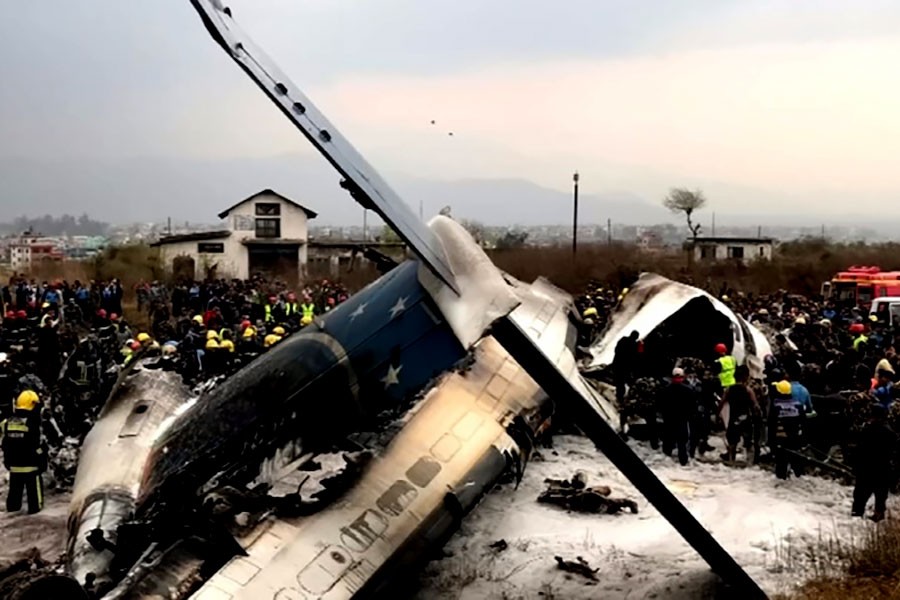Aviation experts have already started the grim task of combing wreckage to find out the actual cause of the crash of the US-Bangla passenger airliner at the Kathmandu Tribhuban airport Monday afternoon. The tragic accident left 49 people -- 26 Bangladeshis, 21 Nepalese, one Maldivian and one Chinese -- dead. However, 10 Bangladeshis and 12 Nepalese, fortunately, survived the crash. Until now the cause of the crash is not clear as the management of the airliner concerned and the Kathmandu airport control tower are making conflicting claims.
One report said the plane carrying 71 people --67 passengers and four crew members -- from Dhaka swerved erratically and flew dangerously low before crashing and erupting into flames at a playground along the Kathmandu airport. Another report claimed that the aircraft had approached the runway from the wrong direction, crashed and burst into flames in a nearby field. The control tower reportedly revealed that the aircraft defied its instruction and tried to land from the wrong direction. Contrary to that claim the US-Bangla management said the control tower advised the pilot wrongly. The pilot was alive and succumbed to his injuries the next day. Could he leave a clue to the accident? If not, the recovered black box may point to the cause of accident.
There should also be proper investigation into the state of the aircraft involved in the accident, for one leading London daily quoting two eyewitnesses said the plane prior to the crash was flying at a dangerously low level and its approach to the runway had not been anyway normal. The aircraft --a Bombardier Dash-8 Q400 -- was reportedly 17 years old. Though the safety record of this type of aircraft has been more or less acceptable since its introduction in passenger flights in 2000, one cannot, however, rule out mechanical or technical trouble as the cause of the Monday's mishap. But one does need to keep in mind the fact that human errors have been primarily responsible for most air accidents until now.
Error on the part of the people manning the air traffic control and the cockpit turns out to be costly often. This is more so in the case of airports like the one at Kathmandu that is considered one of the riskiest in the world, in terms of landing and takeoff. Special training is imparted to pilots prior to engaging them in flights to such destinations. Aircraft and airports of developed countries do also face accidents. Bangladesh's track record as far as the aviation safety situation is concerned has been good, according to rating done by the relevant international agencies.
The families of the victims of the Monday's air crash would want to know about the circumstances in which their near and dear ones had met the tragic end of their lives. But no amount of consolation would be enough for them since their loss is irreparable. These families, obviously, are now in the midst of a psychological trauma. Beside friends and relatives, the relevant authorities should extend help and cooperation to help them overcome this terrible crisis.
The government and the US-Bangla Airline management have already despatched medical personnel and officials to Kathmandu to ensure proper treatment for the Bangladesh nationals injured in the mishap and extend help in identifying the dead and bringing their bodies back home. Hopefully, they will be able to carry out their job smoothly. The latest accident is likely to leave a negative impact on the country's fledgling aviation industry. Safety, undeniably, needs to be geared up always, but the track record of Bangladesh airliners does not make them candidates for punishment, unduly.


